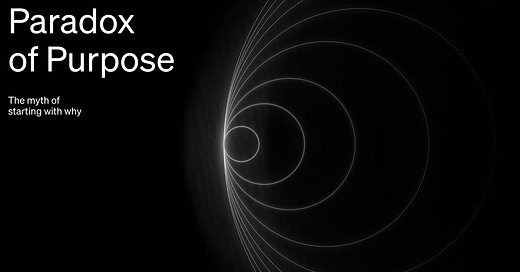We’ve all heard the rallying cry: “Start with why!” It’s inspiring, seductive, and reassuringly neat. But real life—messy, unpredictable, wonderfully alive—often doesn’t follow neat prescriptions.
In our line of work—where each day we articulate the stories of maverick founders and inspiring organizations—the pressure to neatly define purpose from the outset tends to, fairly, present itself quite often.
Yet through many iterations, missteps, and some successes, I've learned to question this tidy narrative, discovering instead a more nuanced interplay between intention and discovery.
Let me introduce a curious, non-business example first… Joe Gardner, the jazz-obsessed protagonist of Pixar’s Soul.
Hear me out.
Soul, understandably, isn’t Pixar’s greatest hit—but it genuinely moved me, and it was certainly far from their worst.
Joe spends his entire existence chasing a single shining purpose: playing jazz on stage with a famous ensemble. He assumes meaning arrives in a singular, monumental moment, like a triumphant crescendo.
Then, Joe falls into a manhole.
Dies.
Escapes limbo.
Reincarnates as a cat.
And finally, through observing his life from the outside, experiences a quiet and profound epiphany.
True meaning wasn’t waiting under the spotlight—it was scattered, hidden in the small notes of everyday life.
A bite of NYC pizza.
Listening to a subway performer.
Getting a good haircut.
Talking to his mom.
Purpose was there all along.
For startups, too, purpose isn't always an initial declaration but a quiet discovery—one that emerges organically through the most important act of action itself.
When we founded Rosaluna, my best friend and I didn’t have a grand mission neatly articulated on day one.
We didn’t even have a clear business plan.
What we had was simpler.
A vision.
An infectious desire to spend evenings lingering a little longer around the table together with friends.
This vision was purely instinctive—a vision of joy, friendship, laughter, and camaraderie.
The purpose—that Rosaluna exists to deepen friendships—came later, naturally and truthfully, revealed in the rhythm of our actions.
Vision, you see, doesn’t demand you know the full "why" from the outset. Vision is curious, playful, imaginative, vivid, and resilient.
It draws you forward, pulls you toward action, experimentation, mistakes, and pivots.
Vision creates space for purpose to beautifully reveal itself through determination and action.
Consider Figma. A cornerstone application in our design process.
At Handstand, we measure time quietly—there’s before Figma, and after.
Initially, founders Dylan Field and Evan Wallace didn't set out with a precise mission to revolutionize design. It was actually far, far, from it.
They explored pretty much everything.
Considering drones: but hardware felt capital intensive.
Gaming: but this was a tough, hit-based business.
They even briefly toyed around with a meme generator. This was actually the first true iteration of Figma.
Uncertainty lingered, prompting questions like, “Is this really what we want to do with our lives?”
The answer, obviously, was “no.”
It wasn’t until they shifted their focus to building collaborative design tools—something that was more aligned with their WebGL-focused skills—that their vision sharpened.
Through this flexibility, engaging directly with users and iterative refinement, Figma's true purpose emerged organically, clearly, and meaningfully, leading to a valuation in the tens of billions—and a tool that would forever change how designers make.
This approach underscores the idea that vision, when acted upon, can lead to a meaningful purpose.
I'm experiencing something similar right now with Handstand. Our studio didn't launch with a neatly defined purpose.
We began simply with a vision—to collaborate with exceptionally creative people and to articulate the stories of remarkable organizations through deep (nerdy) research and action through design.
Our purpose is emerging day by day, continuously reshaped by every slack exchange, every project sprint, every late-night logo epiphany.
It’s not fixed or rigid, but beautifully fluid, evolving naturally in the rhythm of our daily work.
We often mistake purpose as something to be planned and engineered from the outset. Yet experience reveals that purpose rarely emerges through rigid adherence to an initial declaration.
Paul Graham reminds us that the strongest founders aren't defined solely by determination (Determination is incredibly important) but by flexibility—the willingness to swiftly change direction when reality demands it; to be stubborn on the vision, yet flexible on the details.
Startups, artists, and innovators thrive not because they cling doggedly to original intentions, but because they remain curious, responsive, and open to discovering meaning through the unfolding process itself.
Purpose, ultimately, isn't a neat prologue—it’s a profound epilogue.
It emerges not from careful pre-planning or lofty declarations, but through the vivid pursuit of a compelling vision.
Vision is your compass: bold, playful, irresistibly alive.
Action is your dance: improvised, experimental, brimming with possibility.
And purpose? Purpose reveals itself quietly, unmistakably, in the clarity that follows meaningful action.
Joe Gardner found it not in applause but in everyday joys; Rosaluna uncovered it not in a boardroom but in laughter-filled gatherings among friends; Figma revealed it through honest dialogue with users. And at Handstand, we continue discovering ours daily—in the joy of creating, the rhythm of collaboration, and the vibrant uncertainty of new challenges.
So don't get caught trying to engineer the perfect 'why.'
Close your eyes. Dream vividly.
Write down this dream in all its richness and detail.
This is your blueprint.
Now—go dance.
"Your vision will become clear only when you look into your heart. Who looks outside, dreams; who looks inside, awakes." — Carl Jung






This is great!